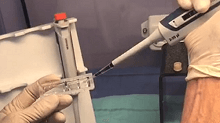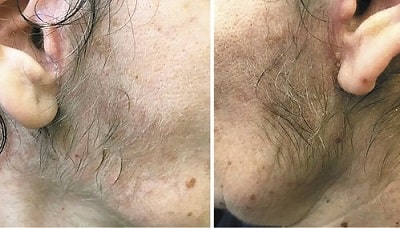I have written numerous posts in relation to fat cells (adipose tissue) and hair growth. There is clear evidence that adipose-derived stem cells (ADSC) on the scalp impact hair growth. The latest trend at hair clinics entails combination nanofat and platelet-rich plasma (PRP) hair growth treatments. Note that instead of nanofat, some also use the term microfat transfer or grafting.
Update: October 2021 — Emerging role of dermal white adipose tissue in modulating hair follicle development during aging.
Nanofat Injections for Hair Growth

During several of last year’s hair loss conferences, a number of presentations entailed nanofat injections into the scalp. Some use the term Autologous Lipocyte Micronized Injection (ALMI) for this procedure.
Most of these fat and adipose-derived stem cell related topics are classified under “stem cell” treatments for hair loss. Note that adipose-derived stem cells (ADSCs) are mesenchymal stem cells (MSCs)
Nanofat injections have been used for many years when it comes to regenerative medicine applications. Usage in hair loss sufferers is more recent. A 2020 study from China found human-derived concentrated nanofat promoted hair growth in mice. The mechanism of action entails activation of dermal papilla cells via the Wnt/β-catenin pathway. Also of interest, a clinical trial from China that tested nanofat grafting for treating androgenetic alopecia ended last year. I am guessing that the results will be published this year.
Perhaps the first study to find benefits from nanofat in male pattern hair loss sufferers came from Italy in 2017. These gains in hair growth lasted even 12 months after initial treatment. The fat was obtained via liposuction using the Tulip Nano device. Also from Italy, Dr. Piero Tesauro is a leading practitioner of nanofat transplantation.
In the US, doctors are increasingly offering combination treatments that include PRP and nanofat. According to Dr. Cheryl Karcher:
“When nanofat is used for hair restoration, she injects it first. She then injects the patient’s PRP on top of it to act as a fertilizer for the nanofat.”
However, in the same article, Dr. Robert Singer warns that there is as yet no safety or efficacy data surrounding nano-fat treatment for hair growth. It should be noted that the somewhat related SVF/Kerastem treatment has shown promising results.
Dermal Adipose Tissue Promotes Hair Growth and Pigmentation
Also of interest, a January 2021 study found that dermal adipose tissue secretes hepatocyte growth factor (HGF). This in turn promotes both human hair growth and hair pigmentation. Among the co-authors of this paper include Dr. Ralf Paus (see Monasterium) and Dr. Maksim Plikus (see Plikus Lab).
What was especially interesting to me in this new 2021 paper was a link to a 2019 paper. Apparently, autologous fat grafting to the face can in rare instances lead to unwanted hair growth (hirsutism). Further evidence of the connection between adipose cells and hair cells.

That’s great admin. But has Dr tsuji secured the fundings yet, to start human trials?
Marc brilliant question as always
Yeah there’s no such thing as a stupid question balding teen!
Just out of curiosity, is there any evidence that autologous fat transfer could regenerate hair follicles in scar tissue? Might be a treatment option for those with facial scars.
JAK-Inhibitors back in the news for Alopecia Areata…
https://www.prnewswire.com/news-releases/baricitinib-is-first-jak-inhibitor-to-demonstrate-hair-regrowth-in-phase-3-alopecia-areata-aa-trial-301239291.html
Also, Histogen will present at the H.C. Wainwright Global Life Sciences Virtual Conference March 9th. Not expecting much here but hopefully some positive news.
JAK is dead..just like Tissue and Follica
Out of topic: is Finasteride all the same? Or some brands work better than others?
I think JAK is not dead at all … its helping a lot against inflamation and skin conditions … https://arcutis.com/pipeline/
https://twitter.com/Hair_Tooth_PJ/status/1367266334040412161
Admin what do you think of riken advertising a shampoo? That doesn’t sound good for there work on hair cloning!
I wrote a post last year on Tsuji working on or mentioning other treatments too, including Adenosine.
Interesting, surely Riken would know that the product works to some degree or they would tarnish their brand name and not be trusted.
They are releasing 3 products for their hair care line…
1. Shampoo
2. Scalp Treatment
3 Essence
There is a peptide that promotes hair growth. It was tested in Dr. Tsuju’s lab (no human trails) none that I know of.
https://translate.google.com/translate?sl=auto&tl=en&u=https://kasui-care.jp/how-to/
Thanks James but does anyone think that Dr tsuji will start human trials this year or next few years ? What do you think admin and Everyone else who reads this. Thanks for any feedback.
Gents,
Did anyone heard of Triple hair company seems like an interesting company with thier products.
(Therapy-07) is going under Phase 3 clinical testing by Q3 of 2021 and seems very promising for androgenic alopecia.
and (Therapy -16)
Which will be realesed by May 2021) —>> showed superior results to minox 5%
Admin,
Would like to hear your thoughts about this company with thier product to be released
Thanks and all the best.
I am optimistic .
The May 2021 product is entirely natural, so I do not have high hopes. If it really surpasses Minoxodil in efficacy in the long run, I would be shocked.
I need an expert opinion. I’ve a NW 2.5, with diffuse thinning, and I believe the sides and back are thinned out a little bit. Is there any hope for me for cloning, or any future treatments? Been on Fin since 2007, I’m 36.
@ Alexander: Hi there, jump on Minoxidil as soon as possible. I started losing my hair when I was 20, Finasteride alone doesn’t do it… I’m 48 now and I still have more than enough hair.
Good luck
Yes Alexander. Sounds like you have my hair loss. Nw 2.5 with thinning top sides and crown. I was on propecia for 12 years with great success but it effects waned and I started thinning again. I added rogaine foam and this grew back some density and slowed my loss down. Still holding on 7 years later slowly losing ground on hair line and sides but 100x better than if I didnt use rogaine. Add nizoral too
Mjones, do you still on propecia as well?
Will do. But what about hair cloning. Are we candidates for that?
How often do you apply Rogaine, and day or night?
Still on propecia. I apply rogaine only at night. No clue if cloning will work. Its not even a reality yet lol. Prob 20 years away before it is figured out, trialed, safe effective and released to mass public at an affordable price.
You honestly think Dr Tsuji’s hair cloning is 20 years away ?
Dr tsuji doesn’t have cloning Alexander. Still pre clinical trials and working on it. Yes I do think 20 yrs. That’s just my gut feeling on it. Let’s hope bayer drug will work and be the next breakthrough that can grow back Norwoods. I have more faith in that than cloning.
Sorry, what is Bayer?
Bayer pharmaceuticals. They have a prolactin drug that tested well with monkeys and they grew tons of hair. Could potentially work for humans since the same monkey was used for minox back in the 80s and the results from that trial showed similar regrowth on humans. Monkey is better than mousr trials.
Thanks for the info! Is there a timeline for this drug?
Not sure on timeline. I think they are starting phase 2 this year. I would say 5 to 7 years for release if it works.
Just been diagnosed with DPA. Pretty sure hair cloning is not an option for me.
Hopefully SM will save my follicles. Hopeful good news soon!